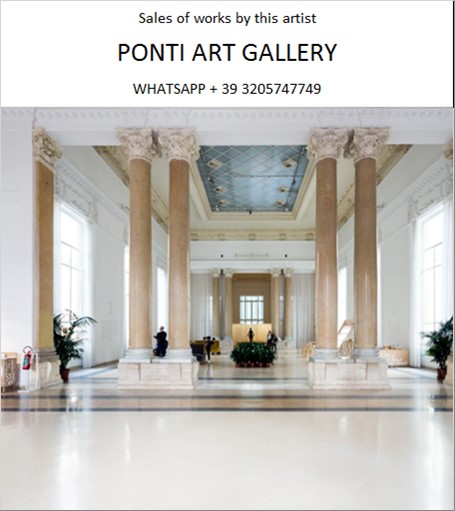Ponti Art Gallery is interested in buying and selling works
of art by this artist.

Graham Sutherland Biography
Graham Vivian Sutherland, born on August 24, 1903, in Streatham, London, emerged as one of the most significant British artists of the 20th century. His journey from an engineering apprentice to a leading figure in the realms of Surrealism and Neo-Romanticism is a testament to his profound artistic evolution and versatility. Sutherland's work, characterized by its abstract landscapes, religious themes, and portraits of public figures, spanned various media including painting, printmaking, tapestry, and glass design.
Sutherland's early life was marked by a brief stint as an engineering apprentice, a path influenced by his family's connection to the locomotive works. However, his true calling lay in the arts, leading him to abandon engineering for Goldsmiths College in London in 1921. Here, under the tutelage of Frederick Landseer Griggs, Sutherland honed his skills in etching and engraving, laying the groundwork for his initial artistic endeavors. His early works, deeply rooted in the Romantic and visionary tradition of Samuel Palmer, showcased finely executed scenes of rural England, reflecting a keen observation of nature and a predilection for the mystical.
The 1930s marked a significant shift in Sutherland's career as he transitioned from printmaking to painting, driven by a decline in the print market and a burgeoning interest in exploring new artistic expressions. His encounter with the landscapes of Pembrokeshire in 1934 profoundly influenced his artistic direction, leading to the creation of semi-abstract, surreal landscapes imbued with a sense of exultant strangeness. These works, characterized by haunting and monstrous shapes rendered in distinctively acidic coloring, signaled Sutherland's departure from representationalism towards a more subjective and metaphorical approach to nature.
Sutherland's contributions as an official war artist during the Second World War added another dimension to his oeuvre. His paintings from this period provided an evocative record of the desolation wrought by the conflict, capturing the industrial scenes on the British home front with a poignant realism. Post-war, Sutherland's work took on a more figurative aspect, beginning with his seminal work, The Crucifixion (1946), for St. Matthew's Church, Northampton. This period saw the integration of religious symbolism with motifs from nature, notably thorns, which Sutherland transformed into powerful and frightening totemic images.
Perhaps one of Sutherland's most famous commissions was the massive central tapestry for the new Coventry Cathedral, Christ in Glory in the Tetramorph, unveiled in 1962. This work, alongside his controversial portraits of public figures such as Winston Churchill, underscored Sutherland's prowess in capturing the essence of his subjects with an expressionistic intensity.
Throughout his career, Sutherland's art underwent continuous evolution, marked by a return to themes of nature and a deepening exploration of religious and existential motifs. His later works, characterized by greater distortion and abstraction, reflected an ongoing dialogue with the landscapes that had initially inspired him, as well as a contemplation of the spiritual and the sublime.
Sutherland's legacy is not confined to his contributions to British art; he also played a significant role in education, teaching at Chelsea School of Art and Goldsmiths College. His influence extended to future generations of artists, including Francis Bacon and Lucian Freud, with whom he shared a mutual respect and artistic dialogue.
Graham Sutherland passed away on February 17, 1980, in Kent, leaving behind a body of work that continues to captivate and inspire. His ability to traverse the boundaries between the real and the imagined, the tangible and the transcendent, cements his status as a master of 20th-century art. Despite the varied phases of his career, Sutherland's work remains unified by a singular vision: an unyielding quest to explore the depths of the human condition and the mysteries of the natural world.
Graham Sutherland Quotes and
Sales of Works
Ponti Art Gallery selects and deals with paintings by the
artist. Upon request, we provide free estimates and
evaluations, communicate prices, quotations, and current
market values.
If you are interested in BUYING or SELLING works by the
artist, contact us immediately.
If you wish to sell or receive an evaluation of the
works:
Send us a frontal photo of the painting, one of the back,
and one of the signature. Also, indicate the dimensions of
the work. Inform us about the purchase origin of the work
and any kind of available documentation (purchase
receipts, certificates of authenticity, publications). One
of our operators will respond to you on the same day. We
guarantee maximum confidentiality and extreme
professionalism.
If you wish to purchase works by the painter: Contact us
and let us know your request. We will inform you about the
available works. We also offer the possibility to
subscribe to our NEWSLETTER, through which you will be
informed at the beginning of each month about the latest
acquisitions of the art gallery.
You can send us pictures of the work:
